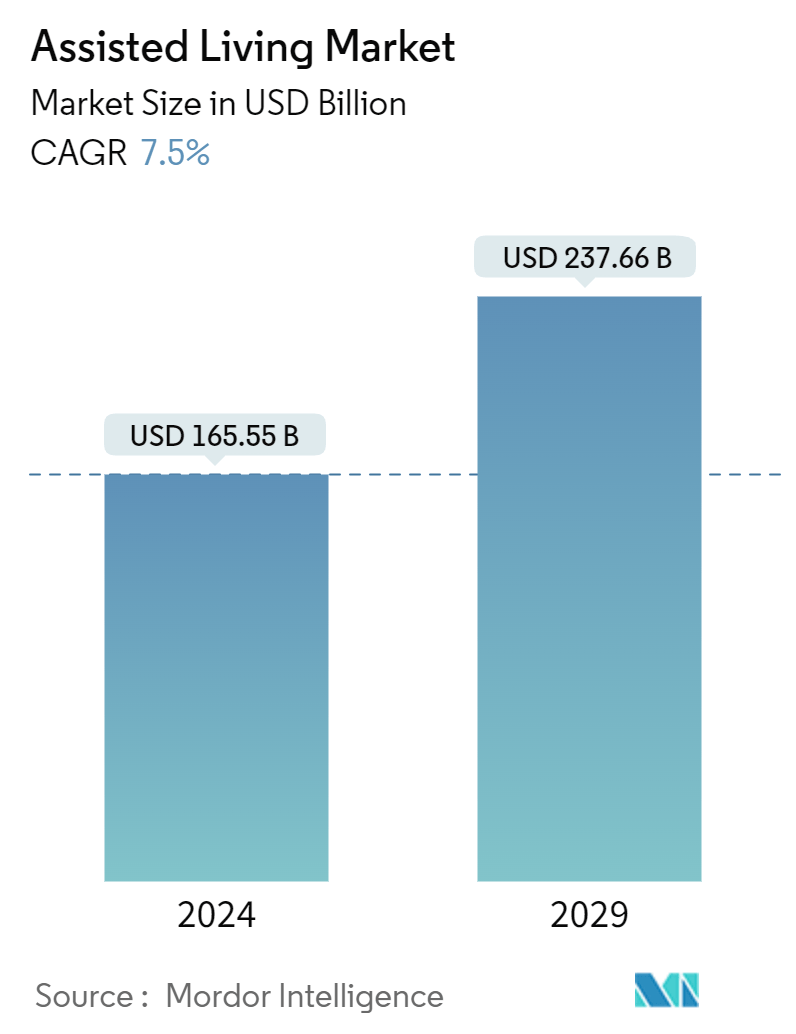Market Size of Assisted Living Industry

| Study Period | 2019 - 2029 |
| Market Size (2024) | USD 165.55 Billion |
| Market Size (2029) | USD 237.66 Billion |
| CAGR (2024 - 2029) | 7.50 % |
| Fastest Growing Market | Asia Pacific |
| Largest Market | North America |
| Market Concentration | Low |
Major Players
*Disclaimer: Major Players sorted in no particular order |
Assisted Living Market Analysis
The Assisted Living Market size is estimated at USD 165.55 billion in 2024, and is expected to reach USD 237.66 billion by 2029, growing at a CAGR of 7.5% during the forecast period (2024-2029).
The assisted living market is experiencing significant growth primarily due to the rising geriatric population, government support, and initiatives. As the aging population increases, the demand for supportive living arrangements that offer both independence and assistance is surging.
The aging population, particularly baby boomers, is a significant driver of the assisted living market. As people age, they often require assistance with daily activities, leading to increased demand for supportive living arrangements. For instance, as per the World Health Organization report published in October 2023, the global geriatric population, comprising individuals aged 60 and above, stood at an estimated 1.1 billion in 2023. This figure represented roughly 13.9% of the world's total population, which was about 7.9 billion. Projections indicate a significant surge in this demographic over the coming decades.
By 2030, the count of older adults is anticipated to hit 1.4 billion. By 2050, that number is set to double, reaching around 2.1 billion and constituting nearly 22% of the global populace. The rising global elderly population is fueling the expansion of the assisted living market. This trend is largely attributed to the challenges many face in managing homes and daily tasks, especially in Western nations where independent living is the norm, thereby boosting market growth.
Furthermore, governments are increasingly recognizing the importance of providing care options for seniors, leading to various initiatives and funding programs aimed at improving access to assisted living. For instance, in October 2023, the US Department of Housing and Urban Development (HUD) administered the Section 202 Supportive Housing for the Elderly program. This initiative offers Capital Advance funding to develop supportive rental housing for seniors aged 62 and older with very low incomes. Additionally, the program provides project rental subsidies to ensure affordability. With approximately USD 115 million allocated, the funding's primary goal is to establish housing that fosters long-term wellness. This enables elderly residents to age in place and receive essential support services like nutrition and transportation. Such support not only makes assisted living more affordable for families but also encourages the establishment of new facilities, thereby expanding the market and enhancing care quality, which is likely to boost market growth.
The combined effect of a rising geriatric population and government support drives substantial growth in the assisted living market. However, high costs, regulatory challenges, and a shortage of skilled professionals hamper the market’s growth.

